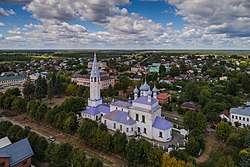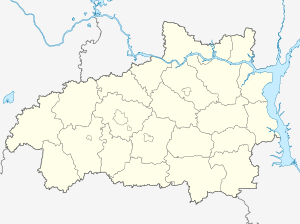Palekh
Palekh (Russian: Па́лех) is an urban locality (a settlement) and the administrative center of Palekhsky District of Ivanovo Oblast, Russia. Population: 5,337 (2010 Census);[1] 5,814 (2002 Census);[5] 6,202 (1989 Census).[6]
Palekh Палех | |
|---|---|
Urban-type settlement | |
 General view of the town | |
.png) Flag .png) Coat of arms | |
Location of Palekh 
| |
 Palekh Location of Palekh  Palekh Palekh (Ivanovo Oblast) | |
| Coordinates: 56°48′0″N 41°51′30″E | |
| Country | Russia |
| Federal subject | Ivanovo Oblast |
| Administrative district | Palekhsky District |
| Area | |
| • Total | 5.8 km2 (2.2 sq mi) |
| Population | |
| • Total | 5,337 |
| • Estimate (2018)[2] | 4,801 (-10%) |
| • Density | 920/km2 (2,400/sq mi) |
| Time zone | UTC+3 (MSK |
| Postal code(s)[4] | 155620 |
| OKTMO ID | 24617151051 |
Painting
Palekh has a very long history in Russian iconography, the art of painting Russian Orthodox icons for homes and churches. The village emerged as a leading center of Russian icon- and mural-painting in the 19th century.
A good example of the Palekh school are the murals and icons from the Church of the Exaltation of the Cross (built in 1762–1774).
Miniature painting
Today, Palekh is known primarily for the Palekh miniature. Following the October Revolution with its outspoken atheist ideology. Around 1923, the Palekh masters of iconography began to paint papier-mâché boxes while applying the same principles they had learned from painting icons. Palekh is the most renowned of the four famous villages, the others being Kholuy, Mstyora, and Fedoskino, each producing similar, yet a very distinct artistic style.
Materials
They used mainly tempera paints of bright colors and painted over a black background. The work usually represents themes from real life, fairy tales, literary works, and folk songs.
References
- Russian Federal State Statistics Service (2011). "Всероссийская перепись населения 2010 года. Том 1" [2010 All-Russian Population Census, vol. 1]. Всероссийская перепись населения 2010 года [2010 All-Russia Population Census] (in Russian). Federal State Statistics Service.
- "26. Численность постоянного населения Российской Федерации по муниципальным образованиям на 1 января 2018 года". Federal State Statistics Service. Retrieved 23 January 2019.
- "Об исчислении времени". Официальный интернет-портал правовой информации (in Russian). 3 June 2011. Retrieved 19 January 2019.
- Почта России. Информационно-вычислительный центр ОАСУ РПО. (Russian Post). Поиск объектов почтовой связи (Postal Objects Search) (in Russian)
- Russian Federal State Statistics Service (21 May 2004). "Численность населения России, субъектов Российской Федерации в составе федеральных округов, районов, городских поселений, сельских населённых пунктов – районных центров и сельских населённых пунктов с населением 3 тысячи и более человек" [Population of Russia, Its Federal Districts, Federal Subjects, Districts, Urban Localities, Rural Localities—Administrative Centers, and Rural Localities with Population of Over 3,000] (XLS). Всероссийская перепись населения 2002 года [All-Russia Population Census of 2002] (in Russian).
- "Всесоюзная перепись населения 1989 г. Численность наличного населения союзных и автономных республик, автономных областей и округов, краёв, областей, районов, городских поселений и сёл-райцентров" [All Union Population Census of 1989: Present Population of Union and Autonomous Republics, Autonomous Oblasts and Okrugs, Krais, Oblasts, Districts, Urban Settlements, and Villages Serving as District Administrative Centers]. Всесоюзная перепись населения 1989 года [All-Union Population Census of 1989] (in Russian). Институт демографии Национального исследовательского университета: Высшая школа экономики [Institute of Demography at the National Research University: Higher School of Economics]. 1989 – via Demoscope Weekly.
